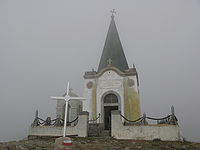
Kajmakcalan
Encyclopedia

Greece
Greece , officially the Hellenic Republic , and historically Hellas or the Republic of Greece in English, is a country in southeastern Europe....
and the Republic of Macedonia
Republic of Macedonia
Macedonia , officially the Republic of Macedonia , is a country located in the central Balkan peninsula in Southeast Europe. It is one of the successor states of the former Yugoslavia, from which it declared independence in 1991...
. It is the southernmost and highest peak (2524 m) of a range known in Greek as the Voras Mountains
Voras Mountains
The Voras Mountains are a mountain range in the Pella Prefecture of Macedonia, Greece, situated in the north-west of the prefecture on the border with the Republic of Macedonia. The tallest peak in the range is Kaimakchalan at ....
and in Slavic Macedonian as Nidže
Nidze
Nidže is a mountain in the southwest of the Republic of Macedonia. The mountain is characterised by almost untouched nature: rich pine forests, lomi, rivers and pastures over 2000 meters. The highest peak is Kajmakčalan at 2521 meters above sea level...
. The national frontier between the two countries runs across the summit. It is the third highest peak in Greece after Mount Olympus
Mount Olympus
Mount Olympus is the highest mountain in Greece, located on the border between Thessaly and Macedonia, about 100 kilometres away from Thessaloniki, Greece's second largest city. Mount Olympus has 52 peaks. The highest peak Mytikas, meaning "nose", rises to 2,917 metres...
and the fifth highest in the former Yugoslav Republic of Macedonia.
Etymology
The word "Kaimaktsalan" is of Ottoman TurkishOttoman Turkish language
The Ottoman Turkish language or Ottoman language is the variety of the Turkish language that was used for administrative and literary purposes in the Ottoman Empire. It borrows extensively from Arabic and Persian, and was written in a variant of the Perso-Arabic script...
origin inspired by its white, snowy peak: kaymakçalan means 'kaimak beater'.
Modern history
During World War IWorld War I
World War I , which was predominantly called the World War or the Great War from its occurrence until 1939, and the First World War or World War I thereafter, was a major war centred in Europe that began on 28 July 1914 and lasted until 11 November 1918...
, in September 1916, the Battle of Kajmakcalan
Battle of Kajmakcalan
The Battle of Kajmakchalan was a battle of the Macedonian Front in World War I. The battle was part of the greater military World War I campaign between the Kingdom of Serbia, on the Allied Side, and the Kingdom of Bulgaria, on the Central Powers...
between Serbia
Serbia
Serbia , officially the Republic of Serbia , is a landlocked country located at the crossroads of Central and Southeast Europe, covering the southern part of the Carpathian basin and the central part of the Balkans...
n and Bulgaria
Bulgaria
Bulgaria , officially the Republic of Bulgaria , is a parliamentary democracy within a unitary constitutional republic in Southeast Europe. The country borders Romania to the north, Serbia and Macedonia to the west, Greece and Turkey to the south, as well as the Black Sea to the east...
n troops took place at Kajmakčalan and around the adjacent peaks, resulting in a Serbian victory. There is a small church and crypt for the Serbian soldiers who died in the battle. Near the top of the mountain, on the Greek side, there is a small church named Profitis Ilias .

